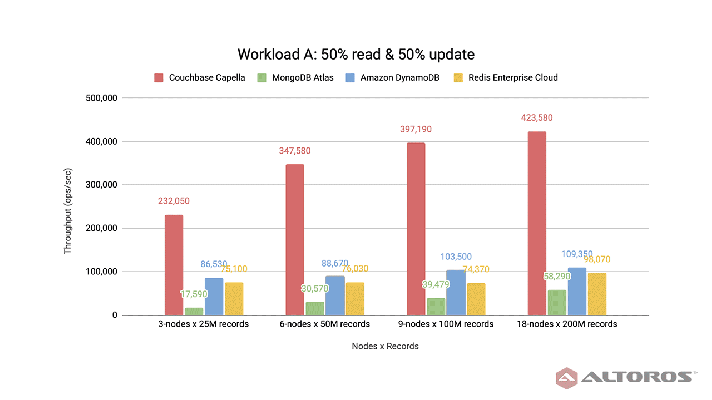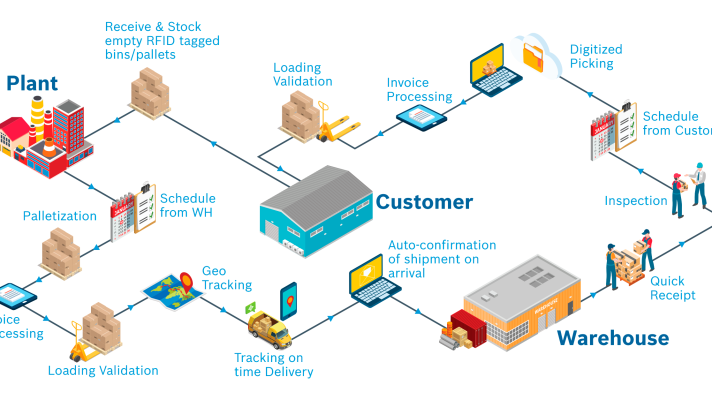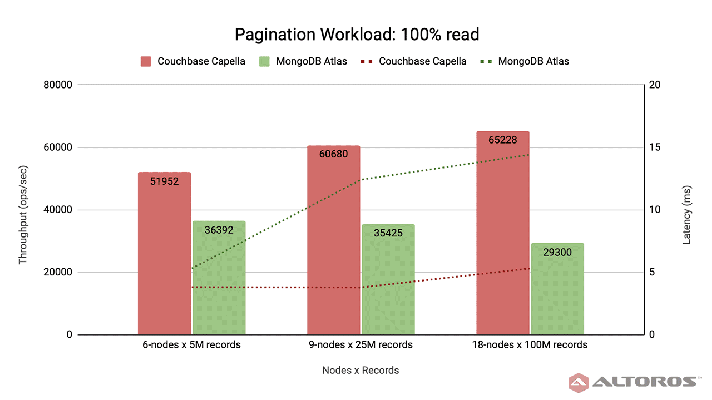A 6-Step Guide to Implementing an Efficient Remote DBA Program
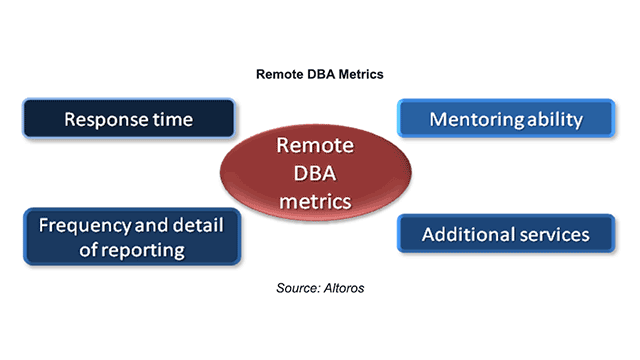
Executive summary
Relational databases, which are by far the most popular kind of databases, are an essential part of every modern business. Maintaining them has grown to be one of the most crucial tasks for enterprises. As a result, today database administration has become one of the hardest challenges businesses may encounter.
Every three years, relational databases like Oracle grow 3x to 5x in size. More than that, enterprises face the necessity of managing a growing number of databases containing more data with increasingly high requirements for uptime and security.
Relational databases, such as Oracle, grow 3x to 5x in size every three years.
The soaring amounts of work are becoming harder and harder for the enterprises’ data administrators to deal with, and eventually employing new personnel seems inevitable. The reality is, trying to catch up with the progress by employing more is not only an unreasonable solution, it also tends to become unfeasible. The reason is that rarely do the budgets allocated for database administration rise as fast as the actual cost of administration, if it is provided by just the internal resources of the company.
These issues, or ideally their anticipation, bring enterprises to realize that a different approach is needed to handle the challenge. And remote database administration (DBA) is quite a different approach. The idea behind remote DBA is simple: you entrust a third-party service provider to take care of your databases. While the general benefits of the approach and its necessity are doubtless, it is important, when deciding on the service provider, to make the right choice.
This article will present a 6-step guide to planning, designing, and managing remote DBA, and explain how to improve return on investment (ROI) and avoid the most common mistakes.
Why remote DBA?
It is hard to imagine a modern enterprise without relational databases. Providing infrastructure for data storage and management, they have grown to be a vital component of both the smaller enterprises, and Fortune 500 giants.
Enterprises often seem to underestimate the role of their relational databases until they run into problems with database administration.
Many enterprises employ just one database administrator. Now, when he or she is not able to do their job (for example, if they take a vacation), their duties are likely to be temporarily handed over to other employees. And are they quite competent to cope with such an important task?
More than that, the huge dependence of the enterprise on one or a few people is always a risk factor. Even when there are two or three people permanently involved with DBA in an enterprise, absence of one of them can be a threat to the smoothness of database administration, taking into account the amount of work and the necessity to reallocate it promptly.
But safety is not the only concern here. Generally speaking, most of a DBA’s workday is spent on repetitive, low-level administrative work, whose ROI is fairly low in spite of its being critical to database maintenance.
Most of a DBA’s workday is spent on repetitive, low-level administrative work, whose ROI is fairly low.
Relying on remote DBA is advantageous in both aspects. On the one hand, it guarantees your data is safe, since taking care of databases is the direct competence of a remote DBA server provider. On the other hand, remote database administration is beneficial financially, ridding the enterprise of such a considerable, yet cost-ineffective expense as keeping internal DBA. Depending on the amount and specific character of work, remote DBA can help cut DBA expenses by 40% or more.
Another huge benefit of remote DBA is round-the-clock database monitoring. 24×7 support is rarely feasible for an enterprise’s in-house staff, both from logistical and cost positions. At the same time, it’s often necessary, particularly for companies that provide a 24-hour interface with customers via the Internet. Remote DBA companies make this possible.
Database administrator’s scope of work
Being a good database administrator requires versatile professional talents, as the process of DBA comprises a number of rather different activities. Performance tuning, troubleshooting, cloning, data modeling, installation, backup, and recovery, all of which are inalienable parts of the database maintaining process, are equally important. And a successful database administrator has to master all of the above. On top of that, good communication skills and other typical (however, not always easy-to-meet) requirements for any person involved in teamwork are still there.
Commonly, a database administration routine comprises such activities as checking alert logs, monitoring performance logs, tuning, applying patches, performing upgrades, installing agents, validating the backup and recovery process, following change management procedures, and addressing requests from application developers, O/S administrators, and end users. Ironically, while playing a crucial role in the support of an enterprise’s infrastructure, these tasks do not relate directly to a company’s core revenue-generating competencies. The return on investment (ROI) of employing internal database administrators, therefore, is rather low; a job of high importance, responsibility, and professional standards turns out to be an unrecoverable cost.
Often, an enterprise’s CEO, feeling this or having figured it out, passes along more work, typically unrelated to DBA, to an administrator. Sometimes, the ROI of this work is higher than one of the tasks in the administrator’s direct competency. By doing so, CEOs demonstrate that they underestimate the extent of the DBA specialist’s business with the database maintenance tasks, and jeopardize the efficiency of this primary mission. As the list above suggests, the scope of a database administrator’s work itself is quite vast, and requires full dedication. At the same time, it is impossible to achieve efficiency of any additional work entrusted to a database administrator without sacrificing the effectiveness of the administration itself.
The problem becomes more and more serious as the amounts of database maintenance work increase. This is where remote DBA steps in, making it possible to free human resources from cost-ineffective work and to avoid hiring additional staff for this sort of work.
Remote DBA life cycle
The life cycle of a remote DBA engagement for an enterprise usually consists of six distinct phases. The diagram below illustrates their chronological order and the way they build on each other.
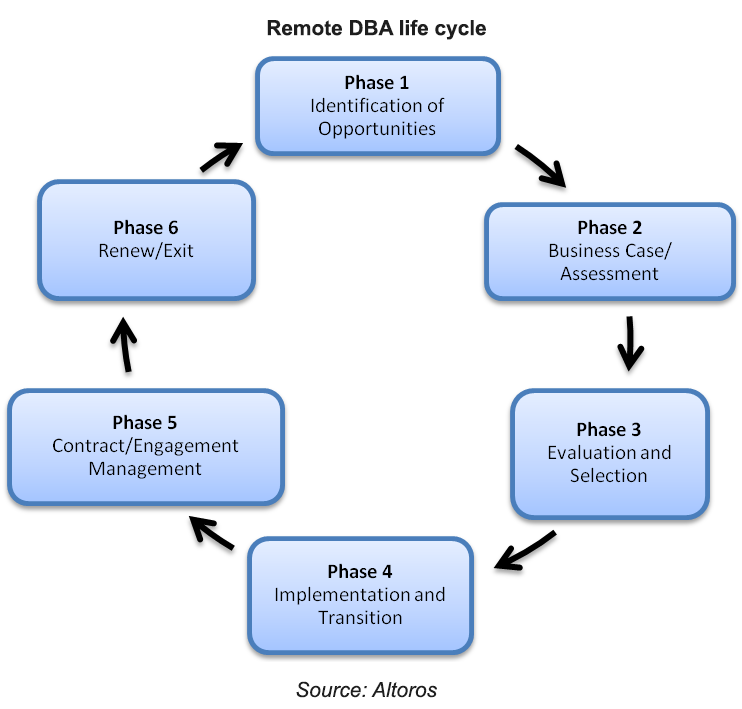
Remote DBA life cycle
Phase 1: Identify remote DBA opportunities
Enterprises face challenges administrating their databases, which brings them to realize that remote DBA is an option to consider. Typically, such challenges are:
- Difficulties managing increasing amounts of information and number of databases
- The riskiness of assigning DBA to one or a small group of executives
- Unprofitable internal database administration caused by its low ROI
- The need for 24×7 support for worldwide implementations
If an enterprise wants to pass the management of only some of their databases to a remote DB administrator, it is important to decide which databases will be passed. Typically, it is useful to keep all of the above factors in mind when making a choice. For example, if there is a database that is rapidly growing in size, crucial to the enterprise’s operation, and requiring 24×7 support, it is a strong candidate for being passed to a remote DBA team.
Phase 2: Assessment/business case
Since data is the key to any enterprise’s functioning, haste is unacceptable when it comes to switching to remote DBA. To forge a successful strategy, some research needs to be conducted. An enterprise may want to carry out a remote DBA “readiness” assessment that will provide it with the information necessary to make key decisions.
Four segments of organizational readiness can be evaluated:
- Business objectives readiness
- Database administration processes maturity readiness
- Cultural readiness
- Financial expectations (desired vs. feasible ROI)
The assessment may apply maturity models based on the Information Technology Infrastructure Library (ITIL) principles.
Investigating the ability and experience of a remote DBA vendor to provide a mixed on-site/off-site approach is highly recommended.
Data for assessment may be gathered from:
- Questionnaires
- Interviews
- Discussion with internal database administrator(s)
- Study of DBA maintenance plans and roadmaps
Deliverables may include:
- DBA readiness report
- ROI analysis
- DBA sequencing plan
- Engagement roadmap
Phase 3: Evaluation and selection
According to the Everest Group, in order to succeed when referring to outsourcing, an enterprise should look for a service provider who meets the following criteria:
- Information technology resources (to eliminate the need for customer investment).
- Process expertise (to streamline the process and make it cost-effective; to focus internal management on core competencies; to take advantage of the vendor’s former experience).
- Economies of scale (to facilitate scalability, globalization, and networks).
- Access to resources otherwise unavailable to the buyer (equipment, applications, capital, people, lower-cost raw materials).
Sometimes, credit and criminal history records checks are recommended as a standard practice for employees and contractors.
Given these criteria, a good remote DBA service provider is a provider who meets the following requirements:
- Experience and deep understanding of the process. Before making a choice, an inquiry into the previous and current remote DBA experiences of the service provider is highly recommended. The team should have a proven track record in all aspects of remote DBA.
- High level of privacy and security. Remote DBA service providers should be prepared to share and review their security policies with you, as well as learn more about your security requirements. Typically, remote DBA services with local offices are reliable because of the strict data privacy laws in the US. Physical security and secure connectivity are also things to ensure.
- Talented team, both locally and remotely. A remote DBA, unlike in-house staff, has to administer several databases at the same time. But, more important, is how they cope with the job. A good remote database service provider can attract and retain highly-qualified and certified DBAs locally to provide on-site services and maintenance work. Be sure to ask for resumes and qualifications of both local and remote DBA team members. Schedule a technical interview to make sure you evaluate their credentials. Sometimes, credit and criminal history records checks are recommended as a standard practice for employees and contractros.
- A reasonable communication plan and readiness to understand the needs of the client in terms of communication. It is vital that before settling with a service provider, you are able to answer the following and other similar questions:
- How often will status reports be delivered to your team?
- Will they be delivered on-site, via e-mail, Web meeting, or conference call?
- How can you schedule a task with the remote DBA team?
- Financial status. The better the status, the more qualified the staff, which a service provider can hire and retain. Financial status is an indication of successfulness, as well, so analyzing the financial reports is also a good idea.
Phase 4: Implementation and transition
This phase comprises making the necessary decisions in order for the remote database administration process to be well-organized and effective.
Firstly, a governing model needs to be established. A rewarding relationship begins with clearly defining the mutual expectations of the company and the remote DBA service provider, which is crucial to the smoothness of the outsourcing management process. An effective governance model should include metrics, payment models, the possibility of renegotiating the terms of the agreement, the pricing structure and fees, the intellectual property issues, the termination options, the rights and restrictions of both outsourcer and company and the liabilities. Service-level agreements (SLA’s), whenever this is possible, should also be included. It is very important that all outsourcing contracts have terms for both termination of cause and termination of convenience. Some exit considerations may be centered on people, equipment, and intellectual properties.
Secondly, the customer and the service provider usually assign a person or a team to manage the evaluation and selection process. Then the customer and the provider work together to conceptualize and to re-confirm the scope of work, the goals, and the activities of the engagement.
The service providers should be included in the enterprise’s planning, since they can be very helpful. To increase motivation, which causes better efficiency in the customer and service provider interaction, incentives can be used.
Finally, according to the evaluation conducted in Phase 3, a communication strategy should be discussed and settled. A clear and effective communication plan is half the key to successful DBA outsourcing.
Phase 5: Contract/engagement management
The essence of remote DBA team management is that from managing resources you switch to managing results. Putting the desired output into focus, such an approach implies ensuring that the result matches the expectations and expresses the enterprise’s true needs. It also makes sure that the results of remote DBA are reported regularly and necessary adjustments are made promptly.
Assessing and adjusting a remote DBA team’s performance regularly—that is, managing it—is an essential part of the routine of an enterprise that opted for remote database administration.
The key to assessing a remote DBA service provider’s performance—and by doing so, growing able to maintain service quality and control the process of database management—is using the right metrics.
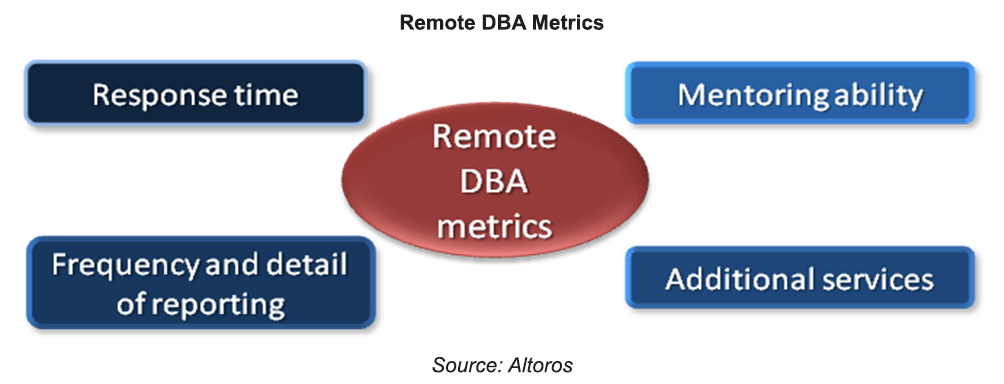
Remote DBA metrics
Some of the metrics that can be used include:
- Response time
- The frequency and detail of reporting
- Helpfulness in terms of mentoring ability (in case some internal DBAs are employed, as well as the remote DBA service provider)
- Availability of optional additional services, such as migrating, security reviewing and planning, performance tuning, backup planning, etc. It is natural for any additional services to cost additional money, though, because if they seem to be “on the house,” in reality it only means that an enterprise is automatically being charged for all the optional services, including those that it does not use.
Remember that the goal of applying such system of metrics is, by measuring and adjusting performance, to build a successful relationship between the client and the service provider.
Phase 6: Renewal/exit
Besides disaster recovery plans, organizations should have an exit plan for remote DBA, as well.
While in this phase, an enterprise should evaluate the outcomes of current outsourcing engagement, compare its initial goals and expectations with the service provider’s actual performance, and make a qualified decision about how to evolve the relationship with the remote DBA team in order to achieve the strategic objectives.
Benchmarking remote DBA: when and why
When an enterprise decides to switch to remote DBA, it typically expects that doing so will help to save quite a part of the budget previously allocated for database administration. While generally the financial benefits of remote DBA are beyond doubt, it is a mistake for an enterprise to think that just clinching the deal guarantees saving. Although some remote DBA teams can propose costs that are half as expensive as employing a full-time database administrator, it is not rare that the lower cost is made up for by poor service. So, benchmarking is required to provide a baseline of costs and service levels. An enterprise can use it to compare the results delivered with the results within the industry, and consequently negotiate or renegotiate the outsourcing deal.
When negotiating, benchmarking knowledge ensures that adequate expectations are set for cost, performance, and the quality of service. When an enterprise has decided to switch to remote DBA and does not intend to carry out a painstaking investigation, wishing to move on through the negotiations fast, benchmarking data can be used as a guide.
Once a deal has been settled, benchmarking can be used for contract refinement. Most outsourcing contracts are renegotiated within two years of being signed. The main reasons for renegotiation are typically dissatisfaction with cost or service quality. Referring to benchmarking data is the main way to make a case with the remote DBA team when renegotiating the contract.
This is why it makes sense that the requirement for benchmarking be included in the final terms of a remote DBA contract. In this case, one can expect that realistic expectations match to a positive outcome.





